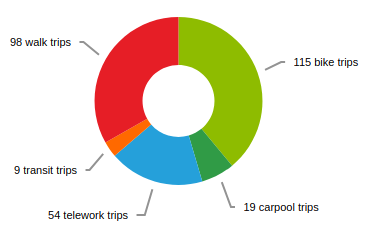Make sure you ask these questions on your next commuter survey
From Corey Tucker, our Program Specialist:
 Commuter surveys are critical tools for generating insights and promoting initiatives that impact commuter behavior.
Commuter surveys are critical tools for generating insights and promoting initiatives that impact commuter behavior.
Running an introductory survey before starting any new program is a great way to establish a baseline for assessing transportation mode-shift. Periodic surveys are also helpful for gathering specific, reliable information that can inform targeted promotions and marketing campaigns.
No two organizations are alike, and predetermining your approach and trying to force it onto your commuter base isn’t likely to work. The data generated by your survey is critical to forming a cogent commuter management strategy that speaks to the needs of the people in your organization.
Good commuter survey questions help commuter services managers create targeted programs. They deliver critical insights that would not otherwise have been apparent, allowing program designers to zero in on strategies that will generate positive and impactful results while delivering tangible benefits to commuters.
With that in mind, here’s a look at my four favorite commuter survey questions, why they work, and when they should be used:
What has been your primary mode of commuting over the past year?
This is the single most important question to establish a baseline understanding of commuter behaviors. How else will you be able to track the impact your changes have made?
By understanding how the lion’s share of your commuters are getting to work, you can also pinpoint the alternative modes they are most likely to adopt. For example, let’s say you’ve got a lot of solo drivers in your organization. You might struggle to get them to give up the convenience of their personal vehicles to adopt a longer, more difficult journey on public transportation.
However, you might have more luck with an employee carpooling program that matches commuters who live close to one another. They can take turns sharing driving duties, enjoying all the benefits of point-to-point private transportation while still contributing to the program’s success.
How familiar are you with employee transportation benefits?
In some cases, businesses that offer transit subsidies, carpooler benefits, secure bike storage, locker rooms, and showers still see little in the way of change. The problem could be that your employees simply aren’t aware that you support alternative commuting modes. This is a great way to find out.
If you determine that a lack of employee awareness is holding back the success of your commuter management programs, make a simple investment in promoting them. Combined with other interventions, this simple change could drive significant shifts in commuter behavior.
What is the main factor in deciding how you’re going to get to work?
To maximize benefits, you have to fine-tune your programs and marketing efforts to make sure they speak to the needs of your employees. For example, if the length of the commute is the primary consideration for your commuters but you’ve built a program that advertises cost savings, you’re not reaching the most important point of appeal.
In our experience, the most successful programs are the ones that deliver the commuter-end benefits team members are looking for. Your commuter survey questions should take a razor-sharp focus in trying to find out what commuters want and need, then tailoring your programs to deliver it.
Would additional benefits or incentives make you more likely to try alternative modes of commuting?
Targeted incentive programming is more effective than broad-stroke programs, so take advantage of questions that reveal exactly what it will take to get commuters to change their habits.
Give people a wide range of options. Parking cash-out programs, points programs, and commuter challenges are all great starting points. For more ideas, check out the San Francisco Department of the Environment’s web portal on commuter benefits: they’ve assembled a strong collection of possibilities.
Commuter surveys are ideal if you’re planning to harness the power of the RideAmigos platform and our data analysis tools to enact positive changes in your organization, and they’re fully supported by our software.
Learn more about using surveys with RideAmigos
 In April 2018, our staff members logged a total of 295 smart trips. We make use of nearly every mode imaginable, from bike commuting to telework and transit, carpools and ride-hailing, walking, running, skateboarding, and e-scooters. If there’s a way to get to work, one of our employees has probably tried it!
In April 2018, our staff members logged a total of 295 smart trips. We make use of nearly every mode imaginable, from bike commuting to telework and transit, carpools and ride-hailing, walking, running, skateboarding, and e-scooters. If there’s a way to get to work, one of our employees has probably tried it!
